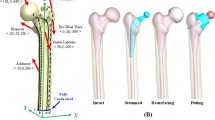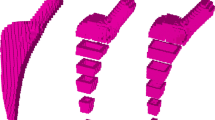Abstract
Background
Regarding the cup setting in total hip arthroplasty, range of motion and prevention of dislocation are important. From past reports, the wear of the bearing surface may affect long-term results. This study evaluated the stress applied to the bearing surface by the combined use of the three-dimensional rigid spring model and the finite-element analysis.
Methods
For contact pressure distribution of the bearing surface, interference analysis was performed using a three-dimensional rigid body spring model. Furthermore, stress was applied to the inner surface of the cup installed in the bone so that the same stress distribution obtained from the interference analysis was achieved. The finite-element analysis was then performed at each condition, which changed the inclination and anteversion angles of the cup to examine the relationship of maximum equivalent stress.
Results and discussion
The maximum equivalent stresses on the bearing surface under the condition with fixation of an anteversion angle of 0° were 0.78, 0.85, and 1.15 MPa at inclination angles of 25°, 40°, and 55°, respectively. The stress value at 55° was approximately 1.5 times greater than that at 25°. The maximum equivalent stresses on the bearing surface under the condition with fixation of an inclination angle of 40° were 0.85, 0.9, and 1.02 MPa at anteversion angles of 0°, 15°, and 30°, respectively. The stress value at 30° was approximately 1.2 times greater than that at 0°. This study suggests that large inclination and anteversion angles may enhance the stress on the bearing surface and affect long-term results.






Similar content being viewed by others
References
Johnston RC, Brand RA, Crowninshield RD (1979) Reconstruction of the hip: a mathematical approach to determine optimum geometric relationships. J Bone Joint Surg Am 61:639–652
Doehring TC, Rubash HE, Shelley FJ, Schwendeman LJ, Donaldson TK, Navalgund YA (1996) Effect of superior and superolateral relocations of the hip center on hip joint forces. An experimental and analytical analysis. J Arthroplasty 11:693–703
Bicanic G, Delimar D, Delimar M, Pecina M (2009) Influence of the acetabular cup position on hip load during arthroplasty in hip dysplasia. Int Orthop 33:397–402
Lewinnek GE, Lewis JL, Tarr R, Compere CL, Zimmerman JR (1978) Dislocations after total hip-replacement arthroplasties. J Bone Joint Surg Am 60:217–220
Widmer KH (2004) A simplified method to determine acetabular cup anteversion from plain radiographs. J Arthroplasty 19:387–390
Yoshimine F (2006) The safe-zones for combined cup and neck anteversions that fulfill the essential range of motion and their optimum combination in total hip replacements. J Biomech 39:1315–1323
Pauwels F (1976) Biomechanics of the normal and disease hip: theoretical foundation, technique and results of treatment—an Atlas. Springer, New York, pp 1–37
Kawai T, Toi Y (1977) A new element in discrete analysis of plane strain problems. Seisan Kenkyu 29:204–207
An KN, Himeno S, Tsumura H, Kawai T, Chao EY (1990) Pressure distribution on articular surfaces: application to joint stability evaluation. J Biomech 23:1013–1020
Bergmann G, Graichen F, Rohlmann A (1993) Hip joint loading during walking and running, measured in two patients. J Biomech 26:969–990
Kennedy JG, Rogers WB, Soffe KE, Sullivan RJ, Griffen DG, Sheehan LJ (1998) Effect of acetabular component orientation on recurrent dislocation, pelvic osteolysis, polyethylene wear, and component migration. J Arthroplasty 13:530–534
Del Schutte H Jr, Lipman AJ, Bannar SM, Livermore JT, Ilstrup D, Morrey BF (1998) Effects of acetabular abduction on cup wear rates in total hip arthroplasty. J Arthroplasty 13:621–626
Ito M, Tokunaga K, Endo N, Takano Y, Yuasa N (2008) The effect of cup placement in cementless total hip arthroplasty on the wear rate of polyethylene. Orthopedics 31:225
Gallo J, Havranek V, Zapletalova J (2010) Risk factors for accelerated polyethylene wear and osteolysis in ABG I total hip arthroplasty. Int Orthop 34:19–26
Georgiades G, Babis GC, Kourlaba G, Hartofilakidis G (2010) Effect of cementless acetabular component orientation, position, and containment in total hip arthroplasty for congenital hip disease. J Arthroplasty 25:1143–1150
Fokter SK, Moličnik A, Kavalar R, Pelicon P, Rudolf R, Gubeljak N (2017) Why do some titanium-alloy total hip arthroplasty modular necks fail? J Mech Behav Biomed Mater 69:107–114
Tsumura H, Kaku N, Ikeda S, Torisu T (2005) A computer simulation of rotational acetabular osteotomy for dysplastic hip joint: does the optimal transposition of the acetabular fragment exist? J Orthop Sci 10:145–151
Author information
Authors and Affiliations
Corresponding author
Ethics declarations
Conflict of interest
Nobuhiro Kaku, Tomonori Tabata, Hiroaki Tagomori, Tetsutaro Abe, and Hiroshi Tsumura declare that they have no conflict of interest.
Rights and permissions
About this article
Cite this article
Kaku, N., Tabata, T., Tagomori, H. et al. The mechanical effects of cup inclination and anteversion angle on the bearing surface. Eur J Orthop Surg Traumatol 28, 65–70 (2018). https://doi.org/10.1007/s00590-017-2025-6
Received:
Accepted:
Published:
Issue Date:
DOI: https://doi.org/10.1007/s00590-017-2025-6




